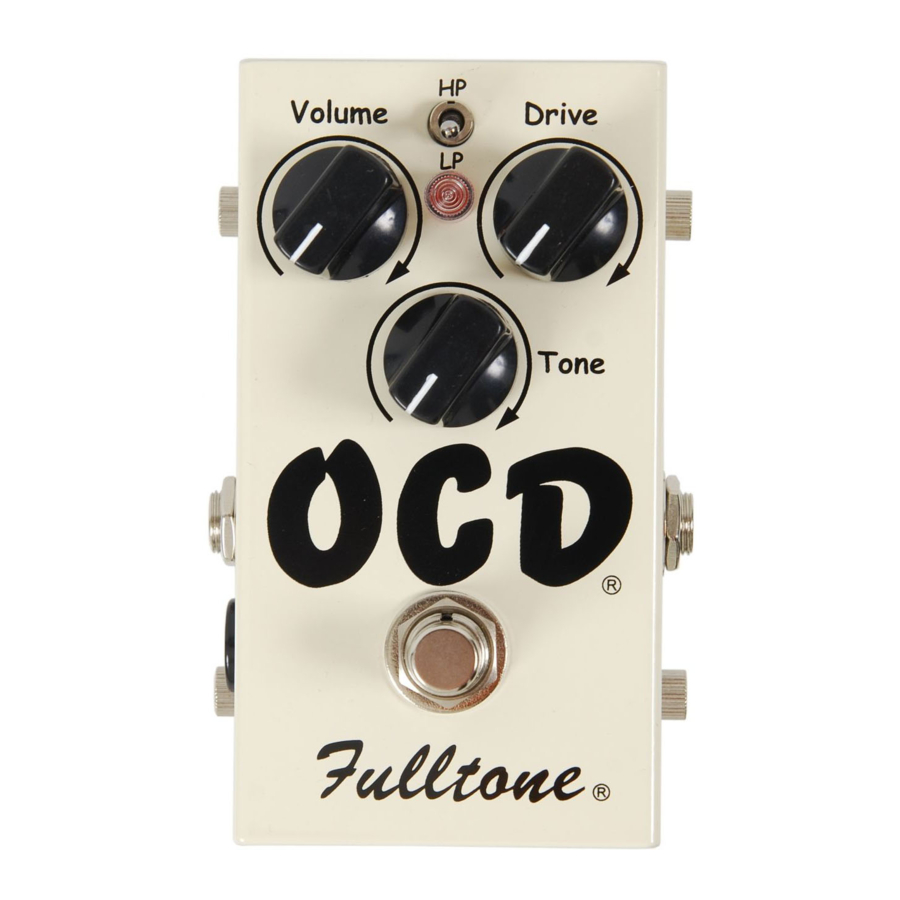
Fulltone Obsessive Compulsive Drive - Music Pedal Manual
- Quick start manual (2 pages)
Advertisement

Introduction
The OCD is an extremely open sounding Overdrive/Distortion circuit is quite different from any overdrive you've tried being that it uses Mosfets for clipping, and that clipping is tied to the circuit's Voltage Reference (vref) instead of to ground. The end-result is that picking soft or picking hard will actually yield a more interactive experience compared to a traditional "diode-to-ground" clipped overdrive. The OCD offers touch-sensitivity, more nuance, and creates complex overtones while keeping the inherent tone of whatever amp and guitar you're playing through! It's like lifting off the blanket that traditional diode-clipped pedals put on your sound.
Because of its huge amount of available output, the OCD works great as an Overdrive in front of amps to goose them into submission, as well as through Master-Volume amps to drive them much harder than most OD's, but it also excels at creating its own distortion with all the chime of a Class A amp and its complex array of overtones. The OCD gives you the feeling that your amp is Cranked at even living room volumes so Clean playing is more dynamic and dirty sounds still have the ringing overtones. And the greatest thing is that you can access a slew of other in-between sounds by simply turning down your guitar's volume control.
Functions
True Bypass switching via the best switch in the world...the Fulltone-made 3PDT footswitch
Drive Knob: Self Explanatory....turn this Clockwise (CW) for more distortion, keep it below 10 0'clock for cleaner sounds and for Overdriving your favorite amp.
Volume Knob: This knob controls the amount of signal that exits the pedal. The OCD has about 30db of available gain, a lot more than most distortion or Overdrive pedals, so don't be surprised if you end up running the Volume control at only around 9 o'clock and are still getting a tremendous volume boost.
HP/LP switch:
Set to HP (High Peak) you get increased Bottom-end, increased distortion throughout the Drive Knob's range, more volume, and a slight increase in upper mids (around the 3.5Khz) for more "British" vibe (ala Vox and Marshall)
Set to LP (Low Peak) you get incredible accuracy to the original sound of your Guitar and amp...very little coloration! Excellent for Clean Boosting, for cranked Blackface or Tweed-style ones, and for when you're not going for a British type sounds.
Tone Knob: This tone knob only affects the high frequencies, you'll find that 12 o'clock position is very much neutral, turn it CCW (counter clockwise) to 10 o'clock or so for smoother high-gain lead sounds (with Drive knob higher than 12 o'clock) or turn it clockwise for more cut, and a less compressed feel.
Battery Included: to access the battery remove all four Thumbscrews from the sides of the pedal and pull the housing apart. Replace battery, put housing back together and re-tighten all four screws. Battery life should be somewhere around 20 hours of use, and always unplug guitar cable from INPUT when not in use to prolong battery life. If you have an adapter plugged in to the DC outlet of the OCD there is no need to unplug the guitar cable from the INPUT because our DC outlet is True-Bypass and disconnects the battery supply line, thus keeping the battery fresh.
DC Power Options You may run this pedal on the (supplied) 9 volt battery OR on ANY voltage between 9 and 18 Volts DC as long as the adapter is (standard) 2.1mm barrel plug with Center-Pin/ Negative...You'll be amazed at the sonic differences; The higher the voltage, the cleaner, louder, and more dynamic the sound, kind of like the difference between a 50 and 100 watt Marshall. Our FPS-1 is a great 9 volt regulated wall wart adapter.
FULLTONE USA, INC,
110 Sports Parkway. Keller, TX 76248
For more info and expanded information & videos go to www.FulltoneUSA.com
Documents / Resources
References
Download manual
Here you can download full pdf version of manual, it may contain additional safety instructions, warranty information, FCC rules, etc.
Download Fulltone Obsessive Compulsive Drive - Music Pedal Manual
Advertisement
















Need help?
Do you have a question about the Obsessive Compulsive Drive and is the answer not in the manual?
Questions and answers